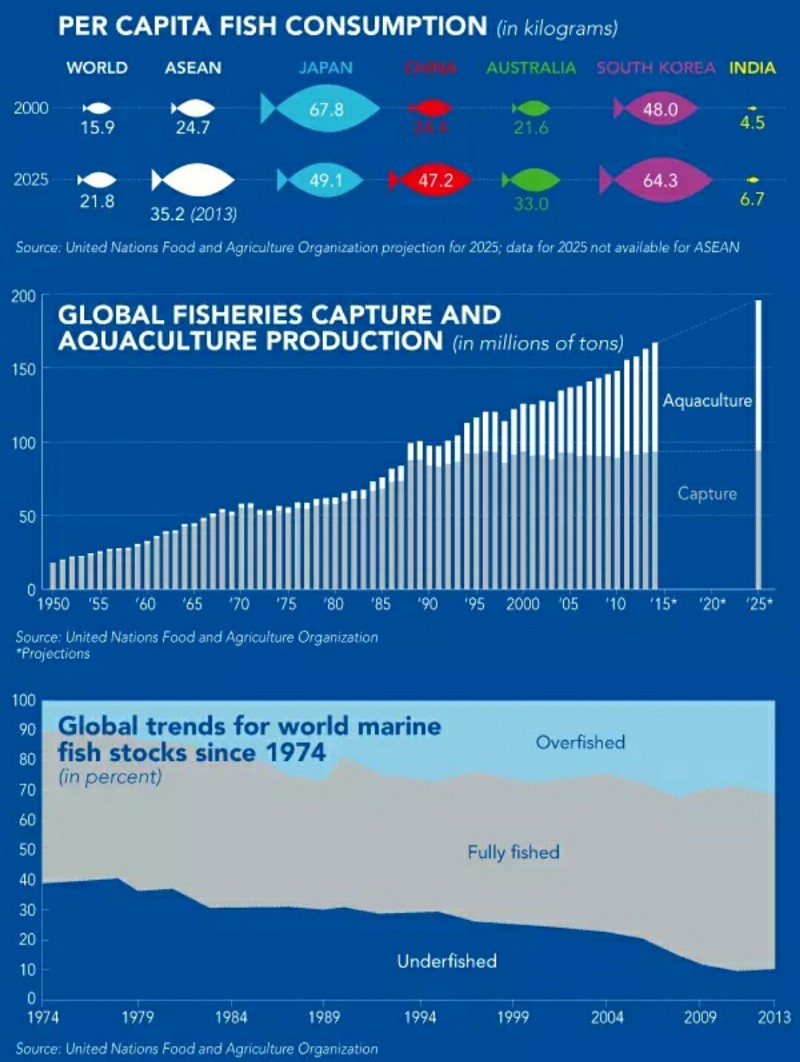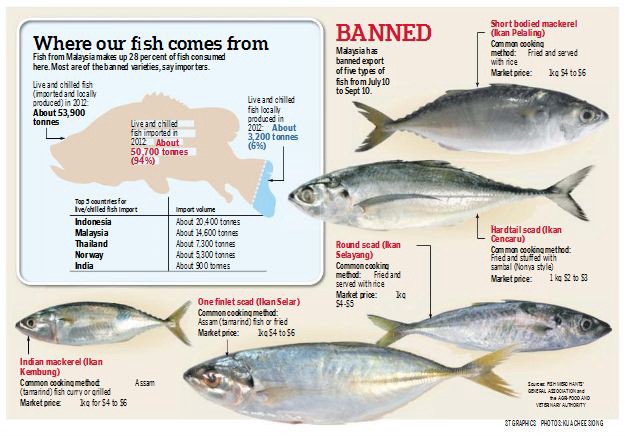“Farming” to Singaporeans typically brings to mind crops like vegetables, fruits, rice, or livestock, poultry and eggs.
But what about fish? Some of us may think our fish are typically wild fish caught by fishermen and farmed fish is just a minor source of our fish.
So why would Singaporeans increasingly buy fish from a farmer instead from a fisherman?
1. There will be less wild fish caught in future
According to the International Union for Conservation of Nature, we are expected to catch less fish in South East Asia in 2050 compared to 1971–2000 level.
Just look at the map below. The waters around Singapore may see a drop in fish catch by 5 to 20%.
Slightly farther away from Singapore, it gets worse, even more than a 40% decrease in fish catch!

2. Increasing demand for fish
By 2025, the average person is expected to consume more fish (with the exception of Japan).
This means if fish supplies do not increase in tandem, fish will command higher prices globally, with the higher bidders being able to afford fish in their meals over poorer ones.

3. We have almost reached the limit of fishing from the sea
According to the United Nations Food and Agriculture Organisation or UN FAO (graph above), close to 90% of world marine fish stocks are either fully fished or overfished, whilst an increasing amount of fish has been coming from aquaculture production.
The future of fish stocks depends on whether aquaculture production of fish stocks can increase quickly enough to satiate the world’s demand for fish.
In Asia, China holds the majority in aquaculture production, but recently bad weather and antibiotic concerns have affected production of some fish stocks, such as tilapia.

In Singapore, most of our live or chilled fish comes from Indonesia and Malaysia.
Tilapia was first introduced to Singapore by the Japanese during WWII.
According to UN FAO, Singapore imports 2,500 tonnes of tilapia a year from Malaysia, China and Indonesia.

But can we always depend on imports, if other countries can choose to ban export of certain fish species for various reasons?

If we want to be a bit more fish-sufficient, how do we even start?
To find out, we visited Opal Resources Pte Ltd, a fish farm at Neo Tiew Lane 1, and interviewed its owner, Mr Alex Siow.
Opal Resources Pte Ltd supplies products such as fish fry and prawn fry to local and overseas fish farms.
According to them, many fish farmers in Singapore favour growing saltwater fish such as grouper or sea bass because the demand for these fish are high, and these fishes are usually carnivorous (meat eaters).
While carnivorous fish are tasty, they need more fish feed to grow to market size. Which means, we will have to import more fish feed to grow them.
If Singapore wants to be less reliant on imports of either fish or feed, we should balance our fish “portfolio” with other fish species which use up less resources (feed) and less space (i.e. can be grown via intensive farming).
Among various research into various fish species that is more resource- and space-productive, tilapia has been highlighted as the “aquatic chicken” because they grow quickly and effectively.

Tilapia aren’t choosy about where they live and eat, and are relatively low on the food chain compared to predatory fish, which means lesser opportunity for mercury to build up in tilapia flesh.
After years of research and selective breeding, tilapia fish have become more “high class” and even can be used for medical purposes.
For example, Taiwan has developed a new breed of tilapia and proudly named them Taiwanese Bream (台湾鲷), and the Japanese are importing these tilapia from Taiwan as they are of sashimi quality.
On top of that, a video circulating online below shows how tilapia is being used in Brazil for helping burn victims heal.
Scientists are also studying using decellularized collagen matrix from tilapia scales for corneal reconstruction.
But why isn’t tilapia fish more popular in Singapore?
“Tilapia is known as Je Pun He locally,” said Alex.
“Tilapia is not one of the foodie’s choices, reason being, the tilapia that we import, mainly from Malaysia, are mostly grown in freshwater pond. Some foodies claim that there is a trace of mud taste in it. But this issue can be solved with a proper management of the water quality and the use of good feed. The fish is as good as what you feed them,” added Alex.
“The strangest thing is, Singaporeans often eat grilled fish sold on the streets of Bangkok without knowing it is tilapia,” said Alex candidly. “Many restaurants in Singapore also serve the pink tilapia (尼罗红).”
Growing tilapia in Singapore seas
Alex also took the opportunity to share the breakthroughs that Opal Resources has achieved.
Through years of selective breeding, they are now able to produce tilapia that can be farmed in sea water.
“We have worked together with a few kelong owners to run a few trials, and the result was fantastic with an astonishing survival rate of more than 90%. We look forward to work closely with the authorities to see how we can scale up the growing of saltwater tilapia.”

After the farm tour, he harvested a few live tilapia and brought it to the nearby restaurant in D’Kranji Resort.
He asked the chef to steam it in Teochew style as he says this is the best way to bring out the original taste of the fish.
The catch, he also says, is that any flaw of the fish will also be exposed via this cooking style.

Alex shared an anecdote of how his son, who dislikes eating fish, enjoyed eating the steamed tilapia freshly caught from his farm.
“I think children’s taste buds are very sensitive. Perhaps that is why they are usually the picky ones in the family. Kids are able to pick up the slightest fishy taste. I guess live fish which are less fishy is acceptable to them,” he said.
True enough, there wasn’t any muddy or fishy taste. The flesh of the tilapia was also tender and slightly sweet.
Since the visit, I’ve introduced frozen tilapia into my occasional steamed meals as a cheaper replacement of my usual frozen salmon.
Tilapia can taste a bit plain without any seasoning, but it works for me and it is reasonably priced (about $4+ for 4 fillets larger than my hand).
And it doesn’t stink up the room like expensive cod fish or saba fish does.
What factors should consumers be aware of when purchasing fish?
Recently, WWF has released a Singapore food guide on recommended species of fish to purchase, which to think twice, and which to avoid.

As a start, if you buy fish, you can consider choosing from the list of recommended fish.
When you purchase fresh fish, choose those with bright clean eyes, bright red or pink gills, shiny skin and firm flesh.

For prepackaged chilled or frozen fish, you may want to consider the country of origin and research about the company supplying the fish.
Fish is an important meat in our cuisine, and although we largely leave it to the authorities to ensure we have enough fish at the right prices, I found it eye-opening to learn:
- how dependent we really are on other countries for our fish
- how we can potentially suffer if we are held hostage by souring bilateral relations or decline in fish stocks
- how we can become more fish-sufficient through careful fish farming and nurseries
- what we can do to be more mindful of our fish-consumption habits, one purchase at a time.
Special thanks for Opal Resources Pte Ltd (Opalresources.sg) for the farm tour and background on fish-farming in Singapore.